- Kenmore refrigerator water filters
- Whirlpool refrigerator water filters
- Samsung refrigerator water filters
- GE refrigerator water filters
- LG refrigerator water filters
- Frigidaire refrigerator water filters
- KitchenAid refrigerator water filters
- Maytag refrigerator water filters
- Kenmore Elite refrigerator water filters
- Estate refrigerator water filters
- GE Profile refrigerator water filters
- Amana refrigerator water filters
- Bosch refrigerator water filters
- Dacor refrigerator water filters
- Electrolux refrigerator water filters
How to replace a trash compactor power switch

This DIY repair guide explains how to replace the power switch on a trash compactor. Located in the control panel, the power switch turns on the trash compactor when you turn the knob. If the power switch breaks, the trash compactor won't start at all. Replace a broken power switch with the manufacturer-approved replacement part.
This repair procedure shows how to replace the power switch on Kenmore, Whirlpool, KitchenAid, JennAir and Maytag trash compactors.
Quick links
Instructions
Tools required
Phillips screwdriver
Pliers
Work gloves
Repair difficulty
Time required
30 minutes or less
Repair difficulty
Time required
30 minutes or less
Instructions
- 01.
Disconnect electrical power
Shut off the house circuit breaker or unplug the trash compactor to disconnect electrical power.
- 02.
Release the front control panel
Open the drawer fully.
Turn the power switch to Off position and pull the control knob off the power switch.
Remove the mounting screws at the top of the control panel.
Pull the control panel out and set it on its face. The wires are still attached to the back of the control switches on the control panel.
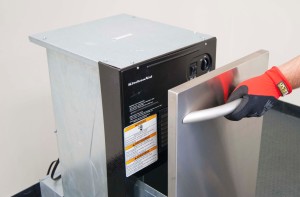
PHOTO: Open the drawer.

PHOTO: Remove the control knob.

PHOTO: Remove the control panel screws.

PHOTO: Fold the control panel down.
- 03.
Remove the power switch
Note the location of the wires connected to the back of the power switch or take a digital photo.
Pull the wires off the power switch.
Remove the circular mounting nut on the front of the power switch.
Pull the power switch from the back of the control panel.

PHOTO: Disconnect the power switch wires.

PHOTO: Loosen the switch mounting nut.

PHOTO: Remove the mounting nut.

PHOTO: Remove the power switch.
- 04.
Install the new power switch
Position the new power switch in the control panel and secure it using the circular mounting nut.
Connect the wires on the back of the power switch, using the digital photo or your notes for reference.
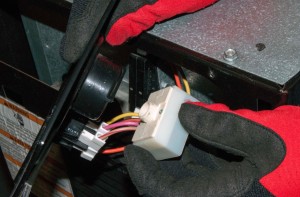
PHOTO: Install the new power switch.
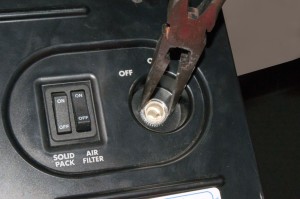
PHOTO: Reinstall the power switch mounting nut.

PHOTO: Connect the power switch wires.
- 05.
Reinstall the control panel
Position the control panel on the front of the trash compactor.
Secure the control panel with the mounting screws.
Reinstall the control knob on the front of the power switch.
Shut the drawer.

PHOTO: Reinstall the control panel.
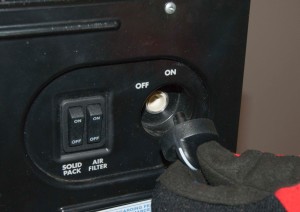
PHOTO: Reinstall the control knob.
- 06.
Restore power
Reset the house circuit breaker or plug the trash compactor back into the wall outlet.
Warning: Undertaking repairs to appliances can be hazardous. Use the proper tools and safety equipment noted in the guide and follow all instructions. Do not proceed until you are confident that you understand all of the steps and are capable of completing the repair. Some repairs should only be performed by a qualified technician.
Most common symptoms to help you fix your trash compactors
Choose a symptom to see related trash compactor repairs.
Main causes: broken drive gear and sprocket chain, stripped power nuts, faulty top limit and directional switch…
Main causes: stuck foot pedal, bad momentary start switch, power switch failure…
Main cause: broken top limit and directional switch…
Main cause: faulty drawer tilt switch …
Main causes: stripped or broken power nuts, broken or disconnected drive gear and sprocket chain, damaged drive parts…
Main causes: bent drawer support rollers, damaged trash container…
Main causes: lack of power, faulty drawer safety switch, bad power switch, momentary start switch failure, bad drive mot…
Most common repair guides to help fix your trash compactors
These step-by-step repair guides will help you safely fix what’s broken on your trash compactor.

How to replace a trash compactor motor centrifugal switch
If the trash compactor ram won’t return to the top position, replace the motor centrifugal switch by following the instr…
Repair difficulty
Time required
45 minutes or less
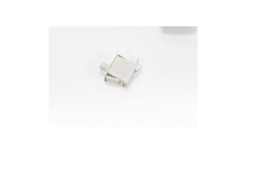
How to replace a trash compactor momentary start switch
The momentary start switch starts the motor when you lift the foot pedal. This repair guide shows how to replace the swi…
Repair difficulty
Time required
15 minutes or less

How to replace a trash compactor power switch
If the trash compactor won’t power up, use the steps in this repair guide to replace the power switch.…
Repair difficulty
Time required
30 minutes or less
Effective articles & videos to help repair your trash compactors
Use the advice and tips in these articles and videos to get the most out of your trash compactor.

Learn about all the convenient features on our Sears PartsDirect website that make your parts purchases easier.…

Get answers to frequently asked questions about Sears and Sears PartsDirect.…

Learn some of the most common symbols found in a wiring diagram and what they mean.…